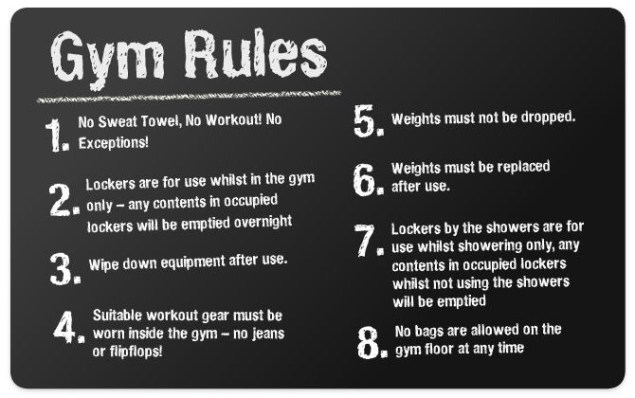(Some language used may be inappropriate and are used for emphasis only. Parental Guidance is recommended.)
The gym is one of my favorite hang outs. Exercise, after all, is one of the key elements to staying healthy. The benefits of regular exercise include:
– feeling happier (with the release of endorphins)
– helps with weight loss or staying fit
– increases your energy levels
– keeps your bones healthy and tones your muscles
– reduces risk of chronic diseases and improves cardiovascular health
– maintains a healthy skin
– helps maintain your mental health
– improves your sleep and helps relax
– reduces pain and improves overall well-being
We all know these benefits and best of it all is that it slows down the aging process.
While the gym is a healthy environment to be in, there are just people who make it a stressful place to be in as well.
Etiquette in a gym is important because it’s a public space. There are other people who share that space with you.
Here are my peeves and my take on etiquette in the gym.
1. Sanitize
Since you’re going to sweat, make sure that you bring a towel and wipe off the sweat you make all over the equipment (and ask the gym for a mop if you sweat all over the floor as well). It’s a good advice that you bring your own towel even if the gym you go to provides you with towels. After all, no matter how the gym washes their towels, you don’t know how clean their laundry services are. Incidentally, all those warts on your skin are most likely from sharing towels.
2. Don’t hog the equipment
Being considerate with other people who need to use the other equipments is important.
If you’re a marathon runner, you probably owe it to yourself to buy your own treadmill. While running is a great fat burner, there are other exercises as well that will help you burn calories.
Don’t park in one equipment especially when you’re taking a call (leave the area and let someone use it first). And make sure that you alternate with others on the equipments. Ask nicely if you can do one rep. I’m sure they’ll always say yes.
3. Bring back the weights
Okay. Fine. So you’re a bodybuilder and you can carry a million tons. Who gives a shit if what you loaded on the barbels are left behind after you use it? I most commonly see this behavior among the teenagers who show off with their peers on who is able to lift the heaviest. When the group is done, they just leave the weights lying around. I usually sidle up to them and tell them firmly – kindly return the weights you’ve scattered to where they are placed.
Once you’re done with the equipment, remove all the weights and put them back to where they belong. Remember – others may not be able to lift as much weight as you do. And leaving some of the barbels on the floor is a recipe for an accident to happen – just because you were too lazy to bring it back.
4. Let others use the weights during your rest period
I mentioned about parking your ass. Well parking the dumbbells by your foot and holding to it for dear life while you’re resting is being rude.
Remember – the reps you do in a weight training program are shorter than the rest time! Why waste everyone’s precious time when we’re all paying the same gym fee? If you want to be treated like a king, go build your own gym!
5. Don’t drop the weights! (Unless it’s an emergency)
Usually this happens if you’re carrying more than what you can. Show off!
These bad things can happen to you when you drop the weights unnecessarily :
– damage the weights and the floor
– accidentally injure other members and yourself
– you can really annoy other members in the gym
Unless you’re going to die in front of everyone, don’t drop the dumbbells.
6. Do unto others you would want others do unto you
Do not blabber on and on to others. Make the conversation light and quick. Not everyone wants to be conservational while working out. The gym is NOT a golf course. This is not the right place to close deals.
Don’t give advice to people unless they ask for it. They may know more than you and may get offended by your “advice” and think that you’re trying to hit it off with them.
Don’t stare! Even if you’re ogling because you find them attractive or envious of their progress. Your staring will not make your body better.
Don’t forget to help people when they need it. When you see someone struggling with the weights, don’t think twice and just help him/her. Don’t look like a snobbish bitch and pretend that you didn’t see the person right beside you has dislodged the 200 pounds barbell. I’m sure you would want the favor returned if this happened to you.
7. Go to the gym like you’re on a date
Dress appropriately. Not like a slut. For guys, wear a jockstrap or underwear and don’t workout commando or freeballing. If s weird and it’s lascivious.
Smell nice. You don’t have to smell like a pimp or someone who took a bath with a gallon of Victoria’s Secret body wash. Just smell nice. Make sure if you have body odor, please paint yourself with all that deodorant. If you can’t smell yourself, I’m sure you can tell when people at the gym avoid you like the plague once you enter the pristine gates.
Keep your cellphone turned off or in mute always. No one wants to hear your Voltes V ringing tone and your blabbing at the top of your voice screaming at your wife who forgot to pay the bills today.
Even if these behaviors don’t get you banned or thrown out from the gym, observing them will end up in unnecessary confrontation with the guy who can lift ten of you over his head.

(p.s., It’s really not nice to lurk in the locker room and make conversations with your friends while your eyes are darting left and right at the other people undressing or be called a pervert!)









